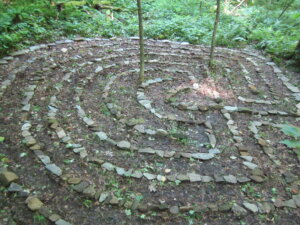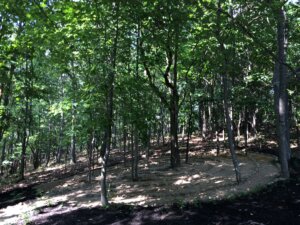Labyrinth expert and designer Dorit Brauer creates unique and one of a kind sacred labyrinths in private and public nature settings.
A labyrinth brings merit and value to every environment. Immediate positive benefits of walking a labyrinth are stress reduction, inner peace, clarity, focus, problem solving and peace of mind. These inner qualities are essential to cultivate in these uncertain times of a global pandemic and allow you build your resilience.
Since my cross-country modern day labyrinth pilgrimage, I had the great privilege to create labyrinths in public and private settings and facilitate countless labyrinth events, guiding the participants to the path of inner peace and wholeness.
What is a labyrinth?
Labyrinths are sacred circles found in every culture around the globe. The 7-circuit labyrinth design dates back thousands of years. Cretan coins show the labyrinth symbol dating as early as 400 BC, into Hellenistic times and continuing into the Roman Empire.
A rich tradition of 7-cirucit labyrinths is found in Scandinavia, Britain and Europe.
The labyrinth is not be confused with a maze, where you can take choices and reach dead ends. Mazes became popular during the period of rationalism in the 15th century, emphasizing reasoning and thinking.
Since the 1990’s the labyrinth movement in the Unites States flourishes with dozens of new labyrinths created every month in public parks, hospital settings, churches, hospices, wellness retreats, prisons and even army bases.
Walking a labyrinth is a relaxing experience. One simply puts one foot in front of the other and trusts the journey, which then automatically leads to the center. The center of the labyrinth is symbolic for reaching one’s inner center and a place of unity.
In 2008 I created the first hospital-affiliated 7-circuit labyrinth at the Cameron Wellness Center in Washington, PA. “The labyrinth is a wonderful addition to our walking trail and supports our commitment to a holistic approach to wellness,” said Gary Weinstein, executive vice president of the Washington Hospital.

View photos of the installation and opening ceremony HERE!
Trees are a beautiful asset to a labyrinth design.
As a former farm girl I love working with the earth and locate the perfect placement to integrate a labyrinth in a natural setting. The following examples show a labyrinth that I built at Piatt Park in West Virginia, and a private labyrinth in the Greater Pittsburgh area, where I also facilitated a meditative wedding labyrinth walk.





The Pittsburgh topography allows for a unique experience of a sacred labyrinth, as this example of a private labyrinth on a hillside, that I designed in 2012, shows.

For very easy maintenance the pathways of a labyrinth may also be laid out with flat stones that are embedded in the grass, so one simply moves the lawnmower over the design.
Create a sacred labyrinth in your own backyard!
Schedule a labyrinth consultation today! Contact Dorit.
Please enjoy the following samples of temporary labyrinths that I created for events and celebrations.
Labyrinth Creation and Facilitation at the Carnegie Museum of Art

Watch the video.
Learn more Dorit’s Labyrinth at the Carnegie Museum of Art
Dorit’s Labyrinth at the Pittsburgh Public Market

Relates Articles:
What’s the Big Deal with Labyrinths?
Dorit’s Presentation at the 2011 Annual Labyrinth Society Conference in Taos, NM.
Dorit’s Presentation at the 2012 Annual Labyrinth Society Conference in Hudson, WI.
Road-Trip Pictures from Dorit’s Modern Day Labyrinth Pilgrimage across the US

